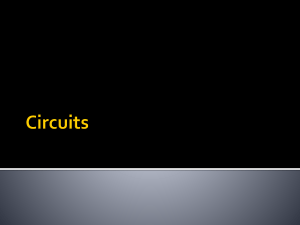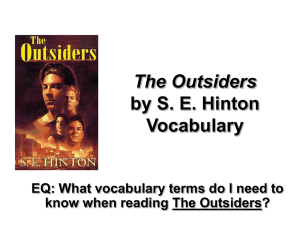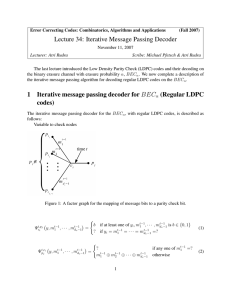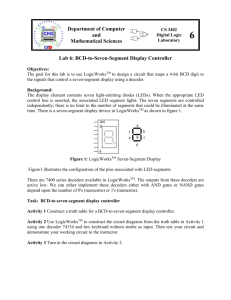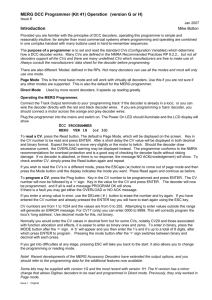Two-bit message passing decoders for LDPC codes over Please share
advertisement
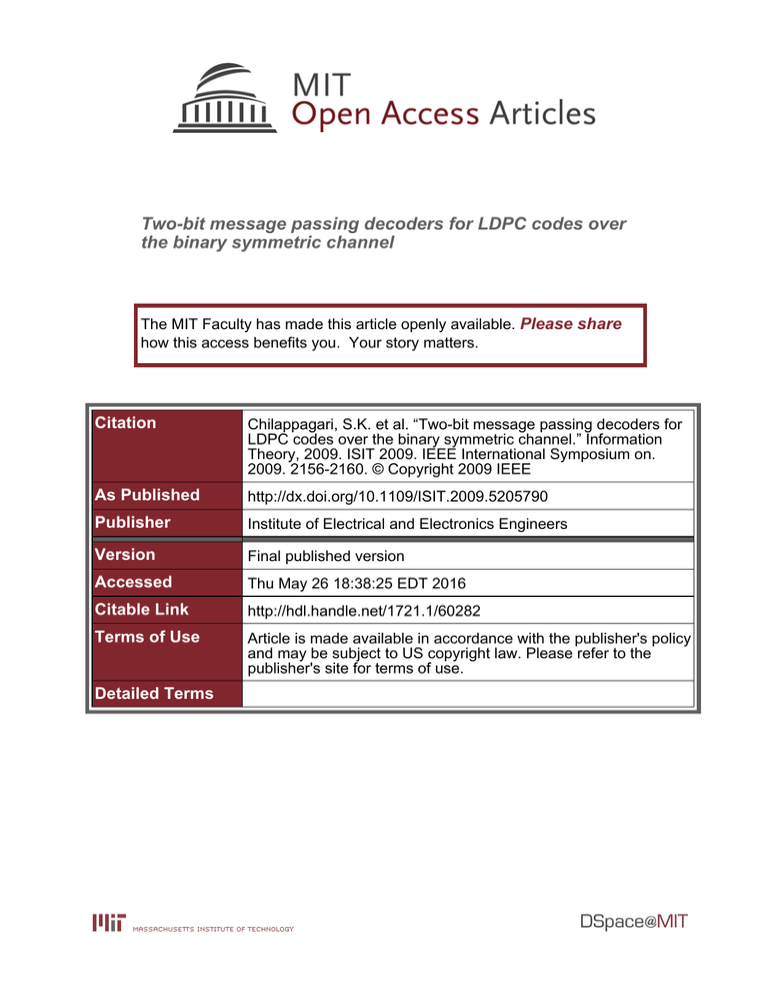
Two-bit message passing decoders for LDPC codes over
the binary symmetric channel
The MIT Faculty has made this article openly available. Please share
how this access benefits you. Your story matters.
Citation
Chilappagari, S.K. et al. “Two-bit message passing decoders for
LDPC codes over the binary symmetric channel.” Information
Theory, 2009. ISIT 2009. IEEE International Symposium on.
2009. 2156-2160. © Copyright 2009 IEEE
As Published
http://dx.doi.org/10.1109/ISIT.2009.5205790
Publisher
Institute of Electrical and Electronics Engineers
Version
Final published version
Accessed
Thu May 26 18:38:25 EDT 2016
Citable Link
http://hdl.handle.net/1721.1/60282
Terms of Use
Article is made available in accordance with the publisher's policy
and may be subject to US copyright law. Please refer to the
publisher's site for terms of use.
Detailed Terms
ISIT 2009, Seoul, Korea, June 28 - July 3, 2009
Two-Bit Message Passing Decoders for LDPC
Codes Over the Binary Symmetric Channel
Lucile Sassatelli
Shashi Kiran Chilappagari, Bane Vasic
David Declercq
LIDS/RLE
Massachusetts Institute of Technology
Cambridge, MA 02139
Email: lucisass@mit.edu
Dept. of Electrical and Computer Eng.
University of Arizona
Tucson, AZ 85721, USA
Email: {shashic.vasicj eaece.arizona.edu
ETIS
ENSEA/UCP/CNRS UMR 8051
95014 Cergy-Pontoise, France
Email: declercq@ensea.fr
Abstract-A class of two-bit message passing decoders for
decoding column-weight-four LDPC codes over the binary symmetric channel is proposed. The thresholds for various decoders
in this class are derived using density evolution. For a specific
decoder, the sufficient conditions for correcting all error patterns
with up to three errors are derived.
I. INTRODUCTION
The performance of various hard decision algorithms for
decoding low-density parity-check (LDPC) codes over the
binary symmetric channel (BSC), has been studied in great
detail. The BSC is a simple yet useful channel model used
extensively in areas where decoding speed is a major factor.
For this channel model, Gallager [1] proposed two binary
message passing algorithms, namely Gallager A and Gallager
B algorithms. The message passing algorithms operate on a
graphical representation of the code, known as the Tanner
graph [2]. Gallager [1] showed that there exist (n, I, p),
P > I 2:: 3 regular LDPC codes of length n with column
weight I and row weight p, for which the bit error probability approaches zero when we operate below the threshold.
Richardson and Urbanke [3] analyzed ensembles of codes under various message passing algorithms and described density
evolution, a deterministic algorithm to compute the thresholds.
Bazzi et al. [4] determined exact thresholds for the Gallager
A algorithm and outlined methods to analytically determine
thresholds of more complex decoders. Burshtein and Miller [5]
considered expansion arguments to show that message passing
algorithms are capable of correcting a linear fraction of errors
(in the code length) when the degree of each variable node is
at least six.
In this paper, we consider two-bit decoders for decoding
column-weight-four LDPC codes over the BSC. Columnweight-four codes are of special importance as their decoders
have low complexity and are interesting for a wide range
of applications. The idea of using message alphabets with
more than two values for the BSC was first proposed by
Richardson and Urbanke in [3]. They proposed a decoding
algorithm, known as the Gallager E algorithm, with erasures
in the message alphabet. The messages in such a decoder
have hence three possible values. They showed that such
decoders exhibit thresholds close to the belief propagation
algorithm. The class of two-bit decoders that we propose is
978-1-4244-4313-0/09/$25.00 ©2009 IEEE
a generalization of their idea, since we consider a message
alphabet with four possible values. We report the thresholds
of various decoders in this class. For the sake of simplicity,
we consider universal decoders, i.e., the decoders which do
not depend on the transition probability of the BSC. Also, we
restrict our attention to static decoders, i.e., the decoders in
which the update rules do not change with the iterations.
For a specific decoder in the class of two-bit decoders, we
derive the sufficient conditions on the Tanner graph of the code
to guarantee the correction of all error patterns with up to three
errors. The problem of correcting a fixed number of errors
assumes significance in the error floor region, where the slope
of the frame error rate (FER) curve is determined by the weight
of the smallest error pattern uncorrectable by the decoder [6].
For iterative decoding over the binary erasure channel (BEC),
it is known that avoiding stopping sets [7] up to size t in the
Tanner graph of the code guarantees recovery from t or less
erasures. A similar result for decoding over the BSC is still
unknown for a large number of cases. For column-weight-three
codes, the necessary and sufficient conditions to guarantee the
correction of three errors have been derived by Chilappagari et
al. [8]. For column-weight-four LDPC codes of girth six, the
sufficient conditions to correct three errors under the Gallager
B algorithm have been derived by Chilappagari et al. [9]. The
conditions that we derive in this paper are similar to the ones
in [9], but impose fewer constraints on the Tanner graph. We
note that the decoder that we consider while not necessarily
the best possible two-bit decoder is easier to analyze and the
methodology in the paper can be extended to other decoders
to yield similar results.
The rest of the paper is organized as follows. In Section II,
we establish the notation and define a general class of two-bit
decoders. For a specific two-bit decoder, the sufficient conditions for correction of three errors are derived in Section III.
In Section IV, we report the thresholds for various decoders.
II. THE CLASS OF TWO-BIT DECODERS
The Tanner graph of a code, whose parity-check matrix
H has size m x n, is a bipartite graph with a set of n
variable nodes and a set of m check nodes. Each variable
node corresponds to a column of the parity-check matrix, and
each check node corresponds to a row. An edge connects a
2156
ISIT 2009, Seoul, Korea, June 28 - July 3, 2009
variable node to a check node if the corresponding element in
the parity-check matrix is non-zero. A Tanner graph is said to
be ,-left-regular if all variable nodes have degree " p-rightregular if all check nodes have degree p, and (n", p) regular
if there are n variable nodes, all variable nodes have degree,
and all check nodes have degree p. The variable degree and
check degree are also referred to as column weight and row
weight, respectively.
Message passing algorithms for decoding LDPC codes run
iteratively. Every round of message passing (iteration) starts
with sending messages from variable nodes to check nodes
(first half of the iteration) and ends by sending messages from
check nodes to variable nodes (second half of the iteration).
Let r == (rl, ... , rn), a binary n-tuple be the input to the
decoder. Let W j ( v, c) denote the message passed by a variable
node v to its neighboring check node c in jth iteration and
W j ( c, v) denote the message passed by a check node c to
its neighboring variable node v. Additionally, let Wj (v, : )
denote the set of all messages from v, W j ( v, : \ c) denote
the set of messages from v to all its neighbors except to c
and W j (: ,c) denote the set of all messages to c. The terms
Wj(: \v, c), Wj(c, : ), Wj(c, : \v), Wj(: ,v) and Wj(: \c, v)
are defined similarly.
Before proceeding to give a formal description of a class of
two-bit decoders, we make the following observation. Since,
the message alphabet is finite, the message passing update
rules can be described using a lookup table and hence only
a finite number of two-bit decoders are possible. Also, the
Boolean function that represents any particular decoder must
be symmetric in the sense that swapping all inputs must imply
a swap of the output. In this paper, we focus on a class of twobit decoders that can be described using simple algebraic rules
and illustrate with an example how the lookup table can be
constructed from the algebraic description.
Let the message alphabet be denoted by M
{-8, -W, W, 8} where -8 denotes a strong "I", -W denotes a weak "1", W denotes a weak "0" and 8 denotes a
strong "0" and 8, WEIR. +. It should be noted that this representation can be mapped onto the alphabet {II, 01, 00, 10}, but
we use the symbols throughout for the sake of convenience.
The received value r v E {O, I} on the channel of a variable
node v is mapped to R; E {C, -C}, C E IR.+ as follows:
1 -----+ -C and 0 -----+ C. It can be seen that each message is
associated with a value and strength (strength of a message is
an indication of its reliability).
Let N 1 ( u) denote the set of nodes connected to node U by
an edge. Let the quantities t j ( v, :) and t j ( v), j > 1 be defined
as follows:
L
tj(v, c) ==
Wj-l(U, v)
+ u;
Additionally, let
II
sign( Wj (c, v)) ==
sign(wj (u, c)),
uEN1 (c)\v
where sign( a) == 1, if a 2:: 0 and sign( a) == -1, if a < o.
The message passing update and decision rules can be
expressed as follows.
W . sign(R v )
For j
8· sign(wj(c,v)),
ifVu E N1(c)\v,
IWj(u, c). == 8
W· sign(wj(c, v)),
otherwise
>1
< Itj(v, c). <
W . sign(tj(v, c)),
if 0
W . sign(R v ) ,
if tj(v, c) == 0
8
Decision: At the end of jth iteration, the estimate r~ of a
variable node v is given by
rv,
if t j ( v) == 0
The class of two-bit decoders described above can be
interpreted as a voting scheme in the following way: every
message has two components namely, the value (0 or 1) and
strength (weak or strong). The sign of the message determines
the value, whereas the values of Wand 8 denote the number
of votes. The received value is associated with C votes. To
compute the outgoing message on the variable node side, the
total number of votes corresponding to 0 and 1 are summed.
The value of the outgoing message is the bit with more number
of votes and the strength is determined by the number of votes.
In the case of a tie, the outgoing message is set to the received
value with a weak strength.
Different decoders in this class can be obtained by varying
the values of 8, Wand C. Hence, we denote a particular
decoder by the triplet (C, 8, W). Since there are only a
finite number of two-bit decoders, different choices for C, 8
and W might lead to the same decoder. The discussion of
the number of unique decoders is beyond the scope of this
paper. Table I shows the message passing update rules for
(C, 8, W) == (2,2,1) for r v == o. The corresponding table for
r v == 1 can be similarly obtained. Table II shows the decision
rules for (C,8, W) == (2,2,1).
uEN1 (v)\c
III. CONDITIONS TO GUARANTEE THE CORRECTION OF
L
In this section, we derive the sufficient conditions on the
Tanner graph of a column-weight-four LDPC code to guarantee the correction of all error patterns with up to three errors.
THREE ERRORS
and
tj(v) ==
uEN1(v)
Wj(u, v)
+ u;
(1)
2157
ISIT 2009, Seoul, Korea, June 28 - July 3, 2009
TABLE I
UPDATE RULE: NUMBER OF MESSAGES -8, -W, WAND 8 GOING INTO
THE VARIABLE NODE V LEADING TO DIFFERENT VALUES OF THE MESSAGE
Wj (V, C) GOING OUT OF V, WHEN THE RECEIVED VALUE IS Tv. THE CODE
HAS COLUMN WEIGHT FOUR AND THE (C, 8, W) = (2,2,1) TWO-BIT
DECODER IS USED.
# -8
Tv = 0
Wj(v, c) = -8
Tv = 0
Wj(v,c) =-W
Tv = 0
Wj(v,c)=W
Tv = 0
Wj(v, c) = 8
mess.
2
3
1
0
2
0
1
1
2
0
0
0
0
0
0
0
0
1
1
1
#-W
mess.
1
0
2
3
0
2
1
1
0
0
0
0
0
1
1
1
2
0
0
0
#W
mess.
0
0
0
0
1
1
1
0
0
0
1
2
3
0
1
2
0
0
1
2
#8
mess.
0
0
0
0
0
0
0
1
1
3
2
1
0
2
1
0
1
2
1
0
TABLE II
DECISION RULE: NUMBER OF MESSAGES -8, -W, WAND 8 GOING
INTO A VARIABLE, WHEN THIS VARIABLE NODE IS DECODED AS 0 (RESP.
1) WHEN THE CHANNEL OBSERVATION IS 1 (RESP. 0). THE CODE HAS
COLUMN WEIGHT FOUR AND THE (C, 8, W) = (2,2,1) TWO-BIT
DECODER IS USED.
# -8
Received value 1
Decoded as 0
Received value 0
Decoded as 1
mess.
0
0
0
0
0
0
0
0
1
1
0
1
1
2
2
2
3
3
3
4
#-W
mess.
0
0
0
0
0
1
1
1
0
0
4
2
3
1
1
2
0
0
1
0
#W
mess.
0
1
2
3
4
0
1
2
0
1
0
1
0
0
1
0
0
1
0
0
#8
mess.
4
3
2
1
0
3
2
1
3
2
0
0
0
1
0
0
1
0
0
0
sets (for the BEC), near codewords, trapping sets (for iterative
decoding on the BSC and the AWGN) and pseudo-codewords
(for linear programming decoding). While girth optimized
codes have been known to perform well in general, the code
length and the degree distribution place a fundamental limit
on the best achievable girth. Hence, additional constraints on
the Tanner graph are required to ensure better error floor
performance.
The guaranteed error correction capability of columnweight-three LDPC codes under the Gallager A algorithm
is now completely understood (see [10], [11] for details).
For column-weight-four LDPC codes under the Gallager B
algorithm, sufficient conditions to guarantee all error patterns
with up to three errors have been derived by Chilappagari et
al. [9]. The conditions derived in [9] impose constraints on the
least number of neighboring check nodes for a given set of
variable nodes. The conditions that we derive are similar, but
impose fewer constraints on the Tanner graph. Due to the close
relationship of the conditions to the notion of graph expansion,
we refer to such conditions as expansion conditions. If every
subset of x variable nodes in the Tanner graph have at least y
neighboring check nodes, we say that the condition x -----+ y is
satisfied.
Before proceeding to the main theorem, we provide some
additional definitions and establish the necessary notation.
Definition 1: The neighborhood of depth one of a node U
is denoted by N 1 ( u) and is composed of all the nodes such
that there exists an edge between these nodes and u. Similarly,
N d ( u) denotes the neighborhood of depth d of node u and is
composed of all the nodes such that there exists a path of
length d between these nodes and u.
(a) Case 1
vi
v§
vi
v§
~
CI C2 C3 C4 C5 C6 C7 Cs Cg CIO
(b) Case 2
v§
v§
~
(d) Case 4
(c) Case 3
(e) Case 5
Since the code is linear and the channel and the decoder are
symmetric, we can assume, without loss of generality, that the
all-zero-codeword is transmitted over the BSC. We make this
assumption throughout the paper. Hence, the variable nodes
flipped by the channel are received as "1".
The problem of guaranteed error correction capability assumes significance in the error floor region. Roughly speaking,
error floor is the abrupt degradation in the FER performance
in the high SNR regime. The error floor phenomenon has been
attributed to the presence of a few harmful configurations in
the Tanner graph of the code, variously known as stopping
Fig. 1. All possible subgraphs subtended by three erroneous variable nodes.
Let E be a set of nodes, say E == UiUi, then the depth d
neighborhood of E is Nd(E) == uiNd(Ui).
Now we state the main theorem",
Theorem 1: [Irregular expansion theorem] Let g be the
Tanner graph of a column-weight-four LDPC code with no
4-cycles, satisfying the following expansion conditions: each
2158
1 The
results have been updated after the submission.
ISIT 2009, Seoul, Korea, June 28 - July 3, 2009
variable subset of size 4 has at least 11 neighbors, each one
of size 5 at least 12 neighbors, each one of size 6 at least 14
neighbors, each one of size 8 at least 16 neighbors and each
one of size 9 at least 18 neighbors. The two-bit decoder, with
C == 2, 8 == 2 and W == 1, can correct up to three errors in
the codeword within three iterations, if and only if the above
conditions are satisfied.
For ease in notation, each expansion condition will be denoted
by "4-----+ 11 expansion condition", "5-----+ 12 expansion condition"
and so on.
Proof of sufficiency:
Remark: The proof can be followed more easily by looking
at Tables II and I. Let VI == {vi, v~ , v§} and C 1 == N 1(VI).
For more easily readable notation, let N 2 (VI) \ VI be denoted
by V 2 and N 1 (V 2 ) \ C 1 by C 2 . Also, we say that a variable
node is of type T$ when it has p connections to C 1 and q
connection to C 2 . The union of order d neighborhoods of all
the T$ variable nodes is denoted by Nd(T$).
We consider all the subgraphs induced by three erroneous
variable nodes in a graph and prove that, in each case, the
errors are corrected. The possible subgraphs are shown in
Figure 1. As shown, five cases arise. In the reminder, we
assume that the all-zero codeword has been sent. For lack
of space, we provide the proof for Case 2. The proofs for
necessity and other cases can be found in the longer version
of the paper [12].
Case 2: Consider the error configuration shown in Figure
l(b).
In the second half of the first iteration, we have:
'W1(C~, v)
v
v
- W,
-w,
'W1(C,v)
'W1(C,V)
W,
E
E
half of the second iteration are such that:
'W2(C,V)
'W2(C~, :)
'W2(C, : \v)
'W2(C,V)
'W2(C, :)
'W2(C, :)
'W2(C,V)
C
v
w,
w,
-w,
W,
W,
S,
v
E
c E
E {vi,v~},
v E Na(Ti),
v E Na(Ti),
v E Na(Ti),
otherwise
W,
S,
otherwise
variables connected to cr and c§.
It results that the set of variables {vi, v~ ,
v§, v} is
connected to only 11 checks, which contradicts the 5-----+ 12
expansion condition. This case is hence not possible.
• v has one neighbor in {ci, c~, c§, cg, c~, c~} and three
neighbors in C 2 nN1(Tl ), say cr, c§ and c§. Let vr, v§
and v~ be the Tl variables connected to cr, c§ and c§.
It results that the set of variables {vi, v~ ,
v§, v~ , v} is
connected to only 13 checks, which contradicts the 6-----+ 14
expansion condition. This case is hence not possible.
• v has four neighbors in C 2 n N 1 (Tl), say cr, c§, c§
and c~. Let vr, v§, v~ and va be the Tl variables
connected to cr, c§, c§ and cl. It results that the set
of variables {vi, v~ , v§,
V§ , v~ , va, v} is connected to
only 15 checks, which contradicts the 8-----+ 16 expansion
condition. This case is hence not possible.
E C1\C~
vr,
vr,
vr,
c E C1\C~
{vi, v~ }
c1
W,
2
nN1(Ti)
v E V , C E {c~, c~, cia, ci1}
c E c: nN1(Ti)
c E c' nN1(Ti)
c E C
2
vr and v§ be the Tl
otherwise
-W,
W,
v E Na(Ti),
• v has two neighboring checks, say cr and c§, in C 2 n
N 1 (Tl ), and two checks in {ci,c~,c§,cg,c~,c~}. Let
In the first half of the second iteration, according to Table
I no -8 messages can be sent by variables neither in V\ VI
because no - 8 message propagate in the first iteration, nor
variables in VI because they all receive at least three W
messages:
W2( v, c)
W2( v, c~)
W2( v~, c)
W2( v, c)
W2( v, c)
W2( v, c)
W2( v, c)
-W,
At the end of the second iteration, all v E VI receive all
correct messages W or 8. According to Table II, all variables
in VI are hence corrected at the end of the second iteration.
For variables in V 2 , since no - 8 messages propagate in the
second half of the second iteration, we see on Table II that
variables in V 2 , which are not received in error, are decoded as
1 if and only if they receive four - W messages. The following
lemma prove that this is not possible.
Lemma 1: No variable node receives four incorrect -W
messages at the end of second iteration.
Proof: Let v be such a variable. Then the four neighboring checks of v must belong to {ci, c~, c§, cg, c~, c~} u
(C 2 n N 1 (Tl)). Note that only two neighbors of v can belong
to {ci, c~, c§, cg, c~, c~} without introducing a 4-cycle. This
implies that there are only three cases:
{vi, v~ }
v",
-W,
W
•
c2
c E c'
1
c E c
c E
Hence, the decoder converges at the end of the second iteration.
•
In the second half of the second iteration, the messages going
out of certain check nodes depend on the connection degree
of these check nodes. However, we do not want that the proof
be dependent on the degree of connection of check nodes.
Hence, we consider in the following the "worst" case, that is
the configuration where each message has the smallest possible
value. In that case, the messages along the edges in the second
Note that similar conditions for a column-weight-four LDPC
code of girth six to correct any weight-three error pattern
within four iterations, when it is decoded with Gallager B
algorithm, has been found by Chilappagari et al. [9]. The
conditions are that each variable subset of size 4 has at least
11 neighbors, each one of size 5 at least 12 neighbors, each
one of size 6 at least 14 neighbors, each one of size 7 at least
2159
ISIT 2009, Seoul, Korea, June 28 - July 3, 2009
TABLE III
THRESHOLDS (GIVEN IN PROBABILITY OF CROSSOVER ON THE BSC) OF
COLUMN-WEIGHT-FOUR CODES WITH ROW DEGREE p. ALGORITHM E IS
PRESENTED IN [3]. FOR THE TWO-BITDECODERS, THE SET (C,S,W) IS
GIVEN.
p
Rate
0.5
0.75
0.875
Rate
0.5
0.75
0.875
Rate
0.5
0.75
0.875
Rate
8
16
32
0.5
0.75
0.875
p
8
16
32
p
8
16
32
p
8
16
32
Gallager A
0.0474
0.0175
0.00585
(U,1)
0.0467
0.0175
0.00585
(2,2,1)
0.0567
0.0177
0.00587
Dynamic two-bit
decoder with
S=2andW=1
0.0638
0.0249
0.00953
Gallager B
0.0516
0.0175
0.00585
(1,2,1)
0.0509
0.0165
0.00562
(2,3,1)
0.0532
0.0168
0.00568
V.
We have considered a class of two-bit decoders for decoding
column-weight-four LDPC codes over the BSC. Codes satisfying the conditions derived in this paper can be constructed by
a modified version of the progressive edge growth (PEG) [13]
algorithm (see [9] for illustration). The question whether all
the valid two-bit decoders can be expressed using the simple
algebraic rules presented in this paper remains open. It is also
of interest to derive bounds on the achievable rate at a given
code length. Future work includes investigation of the above
problems as well as extending the analysis to derive sufficient
conditions to guarantee correction of higher number of errors.
Algoritlun E
0.0583
0.0240
0.00935
(1,3,1)
0.0552
0.0175
0.00486
(3,3,1)
0.0655
0.0222
0.00754
ACKNOWLEDG MENT
16 neighbors and each one of size 8 at least 18 neighbors.
These conditions are stronger than the ones of Theorem 1.
The higher the rate of the code, the more difficult for the
Tanner graph of the code to satisfy the expansion conditions,
since the variable nodes tend to be less and less connected
when the code rate increases. Hence, it is likely that weaker
expansion conditions, obtained for the two-bit decoder, make
possible the construction of higher rate codes, with weightthree error correction capability, than expansion conditions
required by the one-bit Gallager B decoder do. However,
determining analytically the highest achievable rate for a given
set of expansion conditions is a problem which may be very
hard to solve, and which is out of the scope of this paper.
IV.
DISCUSSION
THRESHOLDS OF Two-BIT DECODERS
In this section, we report the thresholds of two-bit decoders
for column-weight-four codes for different values of (C, S,W)
as well as for different code rates. The details of the density
evolution equations are given in [12]. Table III provides the
thresholds for the various two-bit decoders as well as for the
Gallager A, Band E algorithms.
From the table it is clear that there exist two-bit decoders
that have better thresholds than one-bit decoders Gallager A
and B algorithms. However, it should be noted that the class of
two-bit decoders considered in this paper need not necessarily
contain the best possible two-bit decoder. Nevertheless, our
approach can be applied to any decoder to obtain similar
results.
We have also derived the threshold for a dynamic two-bit
decoder i.e., a decoder in which the values of C, Sand W
can vary with iterations. This decoder has the best thresholds
among all the decoders presented. In the dynamic decoder we
consider, the value of C is optimized for every iteration to
achieve a very good threshold. The underlying idea is similar
to the optimization performed in the threshold calculation
of the Gallager E algorithm (see [3] for details). The better
thresholds of the presented dynamic two-bit decoder over
Algorithm E indicates that the potential of using multiple
bits in the message passing alphabet even if the channel
observation is still one bit.
This work has been done while L. Sassatelli was with
ETIS lab, and funded by the French Armament Procurement
Agency (DGA). B. Vasic and S. K. Chilappagari would like to
acknowledge the financial support of the NSF (Grants CCF0634969 and IHCS-0725405).
REFERENCES
[1] R. G. Gallager, Low Density Parity Check Codes. Cambridge, MA:
M.1.T. Press, 1963.
[2] R. M. Tanner, "A recursive approach to low complexity codes," IEEE
Trans. Inform. Theory, vol. 27, no. 5, pp. 533-547, 1981.
[3] T. J. Richardson and R. Urbanke, "The capacity of low-density paritycheck codes under message-passing decoding," IEEE Trans. Inform.
Theory, vol. 47, no. 2, pp. 599-618, 2001.
[4] L. Bazzi, T. Richardson, and R. Urbanke, "Exact thresholds and optimal
codes for the binary symmetric channel and Gallager's decoding algorithm A," IEEE Trans. Inform. Theory, vol. 50, pp. 2010-2021, 2004.
[5] D. Burshtein and G. Miller, "Expander graph arguments for messagepassing algorithms," IEEE Trans. Inform. Theory, vol. 47, no. 2, pp.
782-790, 2001.
[6] M. Ivkovic, S. K. Chilappagari, and B. Vasic, "Eliminating trapping
sets in low-density parity-check codes by using Tanner graph covers,"
IEEE Trans. Inf. Theory, vol. 54, no. 8, pp. 3763-3768, 2008. [Online].
Available: http://dx.doi.org/1 0.11 09/TIT.2008.926319
[7] C. Di, D. Proietti, T. Richardson, E. Telatar, and R. Urbanke, "Finite
length analysis of low-density parity-check codes on the binary erasure
channel," IEEE Trans. Inform. Theory, vol. 48, pp. 1570-1579, 2002.
[8] S. K. Chilappagari, A. R. Krishnan, and B. Vasie, "LDPC codes which
can correct three errors under iterative decoding," in Proc. IEEE Inform.
on Theory Workshop, 2008.
[9] S. K. Chilappagari, A. R. Krishnan, B. Vasie, and M. W. Marcellin,
"Low-density parity-check codes which can correct three errors under
iterative decoding," 2008, submitted to IEEE Trans. Inform. Theory.
[Online]. Available: http://arxiv.org/abs/0810.1105
[10] S. K. Chilappagari and B. Vasie, "Error correction capability of columnweight-three LDPC codes," IEEE Trans. Inform. Theory, accepted for
publication. [Online]. Available: http://arxiv.org/abs/0710.3427
[11] S. K. Chilappagari, D. V. Nguyen, B. Vasie, and M. W. Marcellin,
"Error correction capability of column-weight-three LDPC codes: Part
II," July 2008, submitted to IEEE Trans. Inform. Theory. [Online].
Available: http://arxiv.org/abs/0807.3582
[12] L. Sassatelli, S. K. Chilappagari, B. Vasie, and D. Declercq, "Two-bit
message passing decoders for ldpc codes over the binary symmetric
channel," 2009, submitted to IEEE Trans. Comm. [Online]. Available:
http://arxiv. org/PS_ cache/arxivIpdf/090 1/0901.2090v3 .pdf
[13] X. Y. Hu, E. Eleftheriou, and D. M. Arnold, "Regular and irregular
progressive edge-growth Tanner graphs," IEEE Trans. Inform. Theory,
vol. 51, no. 1, pp. 386-398, 2005.
2160
